|
|
|
Sort Order |
|
|
|
Items / Page
|
|
|
|
|
|
|
| Srl | Item |
| 1 |
ID:
174718
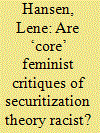

|
|
|
| 2 |
ID:
092347
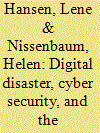

|
|
|
|
|
| Publication |
2009.
|
| Summary/Abstract |
This article is devoted to an analysis of cyber security, a concept that arrived on the post-Cold War agenda in response to a mixture of technological innovations and changing geopolitical conditions. Adopting the framework of securitization theory, the article theorizes cyber security as a distinct sector with a particular constellation of threats and referent objects. It is held that "network security" and "individual security" are significant referent objects, but that their political importance arises from connections to the collective referent objects of "the state,""society,""the nation," and "the economy." These referent objects are articulated as threatened through three distinct forms of securitizations: hypersecuritization, everyday security practices, and technifications. The applicability of the theoretical framework is then shown through a case-study of what has been labeled the first war in cyber space against Estonian public and commercial institutions in 2007.
|
|
|
|
|
|
|
|
|
|
|
|
|
|
|
|
| 3 |
ID:
091561
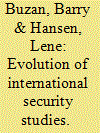

|
|
|
|
|
| Publication |
Cambridge, Cambridge University Press, 2009.
|
| Description |
xiv, 384p.
|
| Standard Number |
9780521694223
|
|
|
|
|
|
|
|
|
|
|
|
Copies: C:1/I:0,R:0,Q:0
Circulation
| Accession# | Call# | Current Location | Status | Policy | Location |
| 054475 | 355.033/BUZ 054475 | Main | On Shelf | General | |
|
|
|
|
| 4 |
ID:
139578
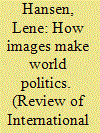

|
|
|
|
|
| Summary/Abstract |
This article introduces international icons to the field of International Relations. International icons are freestanding images that are widely circulated, recognised, and emotionally responded to. International icons come in the form of foreign policy icons familiar to a specific domestic audience, regional icons, and global icons. Icons do not speak foreign policy in and of themselves rather their meaning is constituted in discourse. Images rise to the status of international icons in part through images that appropriate the icon itself, either in full or through inserting parts of the icon into new images. Appropriations might be used and read as critical interventions into foreign policy debates, but such readings should themselves be subjected to analysis. A three-tier analytical and methodological framework for studying international icons is presented and applied in a case study of the hooded prisoner widely claimed to be emblematic of the Abu Ghraib prison scandal.
|
|
|
|
|
|
|
|
|
|
|
|
|
|
|
|
| 5 |
ID:
079788
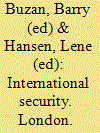

|
|
|
|
|
| Publication |
London, Sage Publications, 2007.
|
| Description |
v1(xl, 430p.); v2(vi, 408p.); v3(367p.); v4(406p.)
|
| Series |
Sage library of international relations
|
| Contents |
Vol 1: The cold war and nuclear deterrence
Vol 2: The rise and fall of the cold war
Vol 3: Widening security
Vol 4: Debating security and strategy and impact of 9-11
|
| Standard Number |
9781412921398
|
|
|
|
|
|
|
|
|
|
|
|
Copies: C:4/I:0,R:4,Q:0
Circulation
| Accession# | Call# | Current Location | Status | Policy | Location |
| 052850 | 355.033/BUZ 052850 | Main | On Shelf | Reference books | |
| 052851 | 355.033/BUZ 052851 | Main | On Shelf | Reference books | |
| 052852 | 355.033/BUZ 052852 | Main | On Shelf | Reference books | |
| 052853 | 355.033/BUZ 052853 | Main | On Shelf | Reference books | |
|
|
|
|
| 6 |
ID:
182442
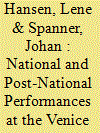

|
|
|
|
|
| Summary/Abstract |
This article makes three contributions to research on visuality and international relations. First, it provides a theoretical framework through which sites and their politics can be understood. Sites are places where certain objects and structures are shown and engaged with. Visitors to sites experience them visually and bodily and visiting sites is a social process. Second, the article introduces the format of the photo essay as an epistemology and a method through which the seeing of sites can be captured. Photo essays about site-specific seeing select photos that convey particular, embodied experiences. Photo essays make photos as important to the analysis as text and they adopt a suggestive form of writing that encourages the reader to see and respond to images in specific ways. Third, the article introduces the Venice Biennale as a site where international relations are performed. National exhibitions called ‘pavilions’ are a central part of the Biennale. Some pavilions invoke ‘the national’ as the privileged lens on world politics, other pavilions challenge this lens. The article provides an analysis of the Serbian, Armenian and Icelandic pavilions in the 2015 Biennale and the national and post-national performances they involved. The analysis draws on an original photo essay composed from a research visit and photo shoot in May 2015.
|
|
|
|
|
|
|
|
|
|
|
|
|
|
|
|
| 7 |
ID:
109589
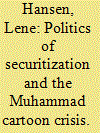

|
|
|
|
|
| Publication |
2011.
|
| Summary/Abstract |
A broad array of authors and schools have influenced Barry Buzan and Ole Wæver's formulation of securitization theory, including John L. Austin, Jacques Derrida and Carl Schmitt. This article draws attention to and strengthens the post-structuralist elements in the writings of Buzan and Wæver, as this part of the theory has received less attention than those attributable to Schmitt and Austin. Starting from securitization theory as developed by Buzan and Wæver and engaging with later expansions of the theory, I suggest a post-structuralist framework built around three questions: Through which discursive structures are cases and phenomena represented and incorporated into a larger discursive field? What is the epistemic terrain through which phenomena are known? And, what are the substantial modalities that define what kind of an issue a security problem is? The last part of the article brings this framework to bear on the 'Muhammad cartoon crisis' that began with the publication of 12 cartoons depicting the Prophet Muhammad in the Danish newspaper Jyllands-Posten in 2005.
|
|
|
|
|
|
|
|
|
|
|
|
|
|
|
|
| 8 |
ID:
113297
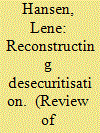

|
|
|
|
|
| Publication |
2012.
|
| Summary/Abstract |
The concept of desecuritisation - the move of an issue out of the sphere of security - has been the subject of heated international political theory debate and adopted in case studies across a range of sectors and settings. What unites the political theory and the applied literature is a concern with the normative-political potential of desecuritisation. This article documents the political status and content of desecuritisation through four readings: one which shows how desecuritisation is a Derridarian supplement to the political concept of securitisation; one which traces the understanding of the public sphere's ability to rework the friend-enemy distinction; one which emphasises the role of choice, responsibility, and decisions; and one which uncovers the significance of the historical context of Cold War détente. The last part of the article provides a reading of the varied use of desecuritisation in applied analysis and shows how these can be seen as falling into four forms of desecuritisation. Each of the latter identifies a distinct ontological position as well as a set of more specific political and normative questions.
|
|
|
|
|
|
|
|
|
|
|
|
|
|
|
|
| 9 |
ID:
110477
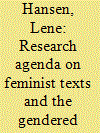

|
|
|
|
|
| Publication |
2011.
|
| Summary/Abstract |
This article starts from two interventions made at the 2008 Millennium Roundtable Discussion on Gender and International Relations: Vivienne Jabri's suggestion that feminist IR might benefit from a closer engagement with the constitution of 'the international' and 'the political' in feminist texts and Christine Sylvester's call for incorporating 'difficult feminisms' that challenge dominant understandings of which political and analytical perspective should be adopted. In response, this article lays out a more concrete research agenda focused on feminist texts that takes an empirically open view of what 'feminism' is and which incorporates factual genres and disciplines beyond political science and philosophy. To provide an example of a reading of 'the international' and 'the political' in a (difficult) feminist text, I turn to Rebecca West's Black Lamb and Grey Falcon, a non-fiction genre-hybrid tome of almost 1200 pages published in 1941. Known to an IR audience mainly through its alleged impact on the Bosnian War, I draw upon works in literary theory and women's studies to bring out West's gendered vision of international politics, giving particular attention to her constitution of the relationship between national, international and women's security. The analysis is divided into four parts which examine the gendering and embodying of empires, the politics of art and aesthetics, sacrifice and submission, and the feminist politics of writing.
|
|
|
|
|
|
|
|
|
|
|
|
|
|
|
|
| 10 |
ID:
073279
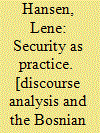

|
|
|
|
|
| Publication |
London, Routledge, 2006.
|
| Description |
xxii, 259p.
|
| Standard Number |
0415335752
|
|
|
|
|
|
|
|
|
|
|
|
Copies: C:1/I:0,R:0,Q:0
Circulation
| Accession# | Call# | Current Location | Status | Policy | Location |
| 051551 | 327.101/HAN 051551 | Main | On Shelf | General | |
|
|
|
|
| 11 |
ID:
103666
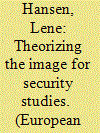

|
|
|
|
|
| Publication |
2011.
|
| Summary/Abstract |
This article provides a framework for the study of visual securitization, that is, when images constitute something or someone as threatened and in need of immediate defense or when securitizing actors argue that images 'speak security'. To study security politics is to focus on the public constitution of threats and dangers; to study visual securitization, therefore, requires an analysis not just of the image as a free-standing entity, but of the ways it is constituted through spoken and written discourse. To analyze the process of visual securitization, this article advances an inter-visual/intertextual model consisting of four components: the visual itself, its immediate intertextual context, the wider policy discourse, and the constitutions of the image. Three additional sets of theoretical arguments deepen this model by pointing to the specificity of the image as comprised through immediacy, circulability, and ambiguity, the strategies of depiction that images employ, and the genres through which images are brought to the audience. The applicability of the theoretical framework is illustrated through a case study of one of the most conspicuous cases of visual securitization: the Muhammad Cartoon Crisis.
|
|
|
|
|
|
|
|
|
|
|
|
|
|
|
|
| 12 |
ID:
182614


|
|
|
|
|
| Summary/Abstract |
The European refugee crisis has been communicated visually through images such as those of Alan Kurdi lying dead on the beach, by body bags on the harbor front of Lampedusa, by people walking through Europe and by border guards and fences. This article examines the broader visual environment within which EU policy-making took place from October 2013 to October 2015. It identifies ‘tragedy’ as the key term used by the EU to explain its actions and decisions and points out that discourses of humanitarianism and border control were both in place. The article provides a theoretical account of how humanitarianism and border control might be visualized by news photography. Adopting a multi-method design and analyzing a dataset of more than 1000 photos, the article presents a visual discourse analysis of five generic iconic motifs and a quantitative visual content analysis of shifts and continuity across four moments in time. The article connects these visual analyses to the policies and discourses of the EU holding that the ambiguity of the EU’s discourse was mirrored by the wider visual environment.
|
|
|
|
|
|
|
|
|
|
|
|
|
|
|
|
|
|
|
|
|